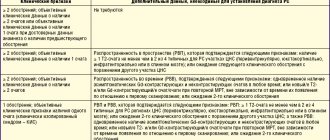Relapsing-remitting multiple sclerosis
Relapsing-remitting multiple sclerosis (RRMS) is the most common type of multiple sclerosis (MS). This diagnosis is made in approximately 85% of cases [1]. Just like other types of the disease, RRMS occurs when the body's immune system attacks the central nervous system, damaging the protein myelin that protects nerve fibers.
The course of the disease is accompanied by various neurological symptoms, such as [2]:
- increased fatigue;
- gait disturbances;
- visual and oculomotor disorders;
- decreased muscle strength in the limbs;
- disorders of sensitivity, urination, etc.
Symptoms can vary greatly depending on the location of the damaged nerve fibers.
Relapses of RRMS last for at least 24 hours. During the period of relapse, all symptoms intensify, but soon a remission occurs, during which the symptoms partially or completely disappear.
Interesting fact
The reasons for the development of relapsing-remitting multiple sclerosis, like other types of MS, are currently unclear. Most likely, the reasons lie in the combined influence of genetic and environmental factors (smoking, vitamin D deficiency, certain infectious diseases) [3].
Many different methods are used to diagnose RRMS [4], but there are no specific tests for this type of disease yet. A neurologist will prescribe a comprehensive examination to assess the severity of the disease, determine the type of MS, and prescribe therapy. It will also be necessary to conduct several diagnostic tests, including magnetic resonance imaging (MRI). An MRI will look for areas of damage in the brain and spinal cord that may suggest the presence of MS. In some cases, a collection of cerebrospinal fluid (lumbar puncture) is necessary.
There is currently no cure that can completely and permanently eliminate the symptoms of any type of multiple sclerosis. However, there are various medications that can control the course of the disease. You should also consider staying physically active to help with mobility issues or muscle weakness. An individualized exercise program helps improve physical fitness and quality of life without exacerbation of disease symptoms or relapse [5].
Interesting fact
The basis of therapy is MS course-modifying drugs (MSDs). These drugs affect the pathological process itself - demyelination - and can reduce the frequency or even completely prevent the occurrence of relapses [6].
There are many different medications on the market, but it must be borne in mind that the selection of therapy is strictly individual and is carried out exclusively by a doctor based on the nature of the disease, existing diseases, and also taking into account previously prescribed therapy.
The prognosis for patients with relapsing-remitting multiple sclerosis is usually more favorable than for patients with a progressive form of the disease [7], but the course of the disease must be assessed over time, since damage to the nervous tissue accumulates over time. Approximately two thirds of patients with relapsing-remitting multiple sclerosis develop secondary progressive MS [8]. On average, this occurs 15-20 years after the onset of the disease [9]. It is this progression that is an important factor in predicting the possibility of developing disability [10].
Multiple sclerosis
| Figure 1. MRI of the brain showing denser areas of white matter typical of multiple sclerosis. |
Morphologically, multiple sclerosis (MS) is characterized by numerous foci of demyelination in the brain and spinal cord, which differ from normal nervous tissue in color and consistency.
Microscopically, this is a picture of periaxial demyelination of nerve fibers. Microglia of the connective tissue grow, and glial scars form, replacing the dead tissue. This forms an inactive MS plaque, which is dense to the touch and has a grayish tint. Despite many years of research, the cause of MS is still unclear. Conventionally, the study of etiological factors can be divided into two groups.
- Study of the genetic factor. MS is a multigene disease involving loci of varying significance in different ethnic groups. The manifestation of a genetic predisposition to MS also depends on external factors.
- Study of the external factor. MS occurs more often in large cities with a population of more than 1 million inhabitants, as well as in people who have numerous contacts with other people due to their profession. A high level of morbidity and its severe course is observed in areas with developed industry and a polluted environment.
External etiological factors also include the infectious factor of exogenous intoxication.
MS Clinic
In the variety of clinical manifestations of MS, two groups of symptoms can be distinguished.
The first group includes the most common classical symptoms, which are a direct manifestation of damage to the brain pathways. This also includes symptom complexes that reflect the characteristics of the clinical manifestations of a multifocal demyelinating process. The second group includes rare clinical manifestations of the disease.
Typical clinical symptoms
Symptoms of damage to the pyramidal tract. This is the most common lesion in MS, accounting for 85-97%. Depending on the location of the lesion, hemi- or paraparesis occurs, and less commonly, monoparesis. The lower extremities are most often affected, less often the upper; they get involved later. Clinically manifested are pathological pyramidal reflexes, increased periosteal and tendon reflexes, decreased or complete absence of abdominal reflexes. The last symptom is a subtle, early manifestation of interest in the pyramidal tract lesion.
Central paresis and paralysis are accompanied by changes in muscle tone - both spasticity and hypotension, dystonia. One of the problems for patients with MS seems to be an increase in tone of the spastic type. As a rule, it is observed in patients with lower paraparesis.
| Multiple sclerosis is a demyelinating disease characterized by signs of multifocal damage to the nervous system. It was first described by Charcot in 1968. The high significance of the problem is determined by its significant prevalence, as well as by the fact that the disease mainly affects young people |
Symptoms of cerebellar damage. Occurs in 62-87% of cases. Patients complain of impaired gait and balance. Clinically manifested by impaired coordination and decreased muscle strength. Dynamic and strategic ataxia, dysmetria, asynergia, intentional tremor, scanned speech, and megalography are common. Characteristic is a paroxysmal increase in ataxia to the point of inability to walk.
Symptoms of damage to the cranial nerves. Observed in 36-81% of cases. Foci of demyelination often form in the intracerebral parts of the nerves, so symptoms of both central and peripheral damage to the motor cranial nerves, most often the III, V, VI, VII pairs of nerves, may be observed. The most common clinical symptom of brain stem damage is oculomotor disturbances that cause double vision.
A characteristic symptom is discoordinated movement of the eyeballs, under-direction of the eyeballs to the sides, and sometimes mild ptosis is observed. Changes in pupillary reactions are rare. One of the main manifestations of MS is nystagmus as a consequence of damage to the upper parts of the trunk.
Symptoms of sensory impairment. Occurs in 56-92% of patients. One of the most common symptoms of MS is changes in deep and superficial sensation. More often in the early stages there is a slight disorder of pain sensitivity and dysesthesia in the distal extremities. A feature of sensitivity disorders is that patients cannot clearly describe them and often complain of numbness and burning in the extremities.
Symptoms of visual impairment. Occurs in 36-52% of cases. Visual disturbances include decreased visual acuity, as well as changes in visual fields. Often retrobulbar neuritis is the first symptom of the disease. An ophthalmological examination reveals central scotomas, narrowing of visual fields, and a transient decrease in visual acuity.
Symptoms of dysfunction of the pelvic organs. Observed in 26-53% of cases. This is one of the first and most common symptoms of MS. Urinary disorders of the central type manifest themselves most early; there can be both frequency and urinary retention, as well as imperative urges. In later stages it is usually urinary incontinence. In men, there may be a decrease in potency associated with damage to the spinal cord due to demyelination.
Neuropsychological symptoms. Occurs in 65-95% of cases. They may include memory impairment, mental acuity, and all sorts of emotional disturbances. Depression with states of apathy and anxiety deserves special attention. Often with MS there is euphoria, combined with a decrease in intelligence. Women experience hysterical reactions, which is the reason for the discrepancy between the patient's complaints and objective neurological symptoms.
Rare clinical manifestations
- Paroxysmal states 5-17%. These may include brief sensory and motor disturbances, tonic spasms, hemifacial spasms, acute attacks of hiccups and yawning.
- Autonomic disorders. These include sympatho-adrenal crises, attacks of hypotension, and bradycardia.
- Symptoms of damage to the peripheral nervous system. This includes polyneuropathy syndrome, as well as the development of muscle atrophy.
MS in childhood
The age limits for MS are currently being revised. There are reports of the development of the disease in both elderly and senile age. But the problem of the disease in childhood is more pressing.
Cases of the development of MS at the age of two have been described, and in the materials of the Research Institute of Neurology of the Academy of Medical Sciences, the earliest onset of the disease is noted at the age of 11-15 years. Diagnosis of MS in childhood is even more difficult due to the variety of syndromic variants and types of course.
Modern methods of diagnosing MS
The polymorphism of MS greatly complicates early diagnosis. The number and range of errors remain significant. The most important diagnostic criteria:
- onset of the disease at a young age;
- polymorphism of clinical manifestations;
- flickering of “symptoms” even throughout the day;
- undulating course of the disease.
The optimal diagnostic algorithm has been determined for examining patients with suspected MS:
- Clinical picture, identification of neurological damage.
- MRI of the brain, spinal cord.
- Ophthalmological examination.
Pathological changes on MRI are most often localized in the periventicular region. Rarely, foci of demyelination are visible in the brainstem and cerebellum. There is no clear connection between the number of demyelination foci and the severity of the disease.
Differential diagnosis of MS
In the initial stages, MS should be differentiated from VSD, neurotic disorders, Meniere's syndrome, retrobulbar neuritis, tumors of the brain and spinal cord, cerebellum, disseminated encephalomyelitis, and degenerative diseases of the nervous system. Spinal forms of MS may present similarly to spinal cord tumors. But the symptoms of MS in the initial stages are characterized by less severe paresis, sensory and pelvic disorders. MS differs from Strumpel's disease in the presence of signs of damage to other parts of the nervous system.
Flow options and forecast
The course of MS is chronic. Most clinics use the following terms to refer to periods of illness.
- Exacerbation: the appearance of a new symptom or group of symptoms after the patient's condition has remained stable for a month.
- Remission: a clear improvement in the patient’s condition in the form of a decrease in the severity or disappearance of a symptom or group of symptoms, which lasts at least a day.
- Chronic progression: an increase in the severity of the disease symptom within two months without stabilization of the condition.
- Stabilization: absence of exacerbation, progression and remission for at least one month.
- Remitting course: a course with exacerbations and remissions without signs of progression. There are also mild and malignant forms of MS. The first includes a long course (10-15 years or more) of the disease, accompanied by minimal disturbances. With a malignant course, the patient becomes completely disabled within the first five years.
If people over 40 years of age fall ill, and the disease is remitting in nature with the first remission of at least a year and the duration of the first exacerbation of no more than three months, then we can talk about a favorable disease process. All other cases are considered unfavorable.
MS treatment
Treatment of MS consists of measures aimed at combating demyelination of the central nervous system and symptomatic therapy. Methods aimed against demyelination include the treatment of exacerbations and chronically progressive disease. Some types of therapy can reduce the frequency and severity of relapses. Since none of the known methods causes remyelination, the main task is to slow down or stabilize the growth of the neurological defect.
Corticosteroids and ACTH drugs remain the drugs of choice for the treatment of MS. It is believed that their use is especially indicated during acute episodes and frequent relapses.
These agents are designed to limit the inflammatory process and the degree of myelin destruction.
One treatment for MS is plasmapheresis, usually in combination with hormone therapy. A positive effect is observed during treatment with betaferon. It is effective mainly in relapsing-remitting forms of MS. It is prescribed to reduce the frequency of exacerbations, as well as to reduce the rate of progression of the pathological process. This suggests that betaferon does not cure completely, but only stops the progressive development of the disease.
As for the effectiveness of biological drugs, it is difficult to judge this, since there are no objective laboratory markers to assess the activity of the demyelinating process.
Symptomatic treatment of MS includes treatment of spasticity and flexor spasms. In these cases, muscle relaxants are used.
During the period of remission, restorative, nootropic, vascular therapy is prescribed, and physical activity is encouraged.
For the purpose of prevention, patients should avoid injections, intoxication, overwork; climate change is not recommended; hyperinsolation is contraindicated. We are discussing the issue of pregnancy and childbirth, although more often in the literature there is evidence of exacerbation of the disease during this period.
Clinical case
| Figure 2. Computer tomography of the brain: changes characteristic of multiple sclerosis were revealed |
A 32-year-old woman complained of transient weakness in her left arm and leg for a year. This symptom had almost completely disappeared two months before hospitalization, but during the last week before hospitalization the left leg became so weak that the patient often stumbled when walking. Over the past three months, there has been intermittent urinary incontinence. At the age of 18 years, there was an episode of diplopia, which spontaneously regressed.
A neurological examination revealed pallor of the temporal half of the left optic nerve, weakness in the left hand when shaking, increased reflexes on the left extremities, absence of superficial abdominal reflexes on both sides, Babinski's sign on the left. A hemiplegic gait was observed. Myelography and cerebrospinal fluid examination revealed no pathological changes. Characteristic changes were revealed on CT (Fig. 2)
Thus, the patient was diagnosed with multiple sclerosis.
Treatment of multiple sclerosis at Hadassah Medical Center
Multiple sclerosis is an autoimmune disease .
In autoimmune diseases, the immune system mistakenly attacks healthy parts of the body. In this case, the central nervous system, that is, the brain or spinal cord, is affected. In MS, the immune system attacks the membranes that surround and protect the nerves (myelin sheaths). As a result, the myelin sheath is damaged and scarred. This can cause nerve damage. Nerve damage, in turn, slows down or disrupts signals transmitted throughout the nervous system.
Scientists do not yet know why such disruptions occur in the immune system. Most experts believe that pathology develops under the influence of several genetic and environmental factors .
Multiple sclerosis develops in one of two ways: either through isolated relapses (in the form of attacks or exacerbations) or through gradual progression.
The relapsing-remitting type of the disease is diagnosed in more than 8 out of 10 patients with multiple sclerosis. In relapsing-remitting MS, attacks, or exacerbations, of symptoms occur. In this case, a person either develops new symptoms or already known manifestations of the disease intensify. Each attack worsens over several days, lasts for days, weeks or months, and then slowly passes over the same period. An exacerbation usually begins unexpectedly, although in some cases it is caused by a long-term illness or stress.
Symptoms of relapse may disappear permanently even without treatment. Some of these symptoms, however, are persistent, with exacerbations occurring regularly over several years. The periods between attacks are called periods of remission. Remission may last several years.
After many years (usually decades), relapsing-remitting MS progresses to secondary progressive multiple sclerosis . It should be noted, however, that this does not happen to all people with MS. In secondary progressive multiple sclerosis, symptoms worsen gradually, without obvious attacks. Some people still experience rare flare-ups at this stage. Secondary progressive MS develops in approximately half of patients with relapsing-remitting multiple sclerosis. The transition of pathology from one form to another occurs within 15-20 years. The risk of such a transition increases in proportion to the duration of the disease.
Primary progressive multiple sclerosis. The development of MS begins with a gradual worsening of symptoms in approximately 1 in 10 cases. With primary progressive multiple sclerosis, the symptoms of the disease gradually intensify and accumulate over several years. There is no remission. However, during the course of the disease there are often periods during which the patient's condition seems to stabilize.
Stages of multiple sclerosis
Multiple sclerosis (MS) is a complex disease that affects the central nervous system. Symptoms of MS occur when the body's immune system mistakenly begins to attack nerve fibers, or more precisely, the protein membrane around them [1]. The damage affects the transmission of signals along the nerves that need to travel from the brain and spinal cord to various parts of the body. Because MS can affect many different body functions, each patient experiences symptoms slightly differently [2].
There are four main types of MS, which differ in the nature of their course and progression [3]. Studying each of these types of disease allows us to improve diagnostic and treatment methods. Let's figure out what types and stages of MS exist.
Clinically isolated syndrome (CIS)
CIS is the first and only clinical episode of neurological dysfunction caused by damage to one or more parts of the central nervous system (CNS), lasting more than 24 hours, while the available clinical data and MRI images do not meet the criteria for diagnosing MS [4]. In order to accurately determine whether a person has MS, it is necessary to see a doctor. For diagnosis, your doctor may order an MRI to look for active nerve damage or traces of it. Early treatment of CIS can help delay the onset of the disease.
Relapsing-remitting MS (RRMS)
Most people develop this type of MS [3]. In the life of a patient with RRMS, there will be periods of improvement and worsening of symptoms. After each exacerbation, there may be a fairly long period during which the symptoms improve or may disappear completely before the next relapse. However, in some cases, symptoms become permanent, and during remissions the person’s condition only improves slightly. The severity of symptoms may vary depending on the extent and location of the nerve damage. Because of this, the time of remission also varies.
Primary progressive MS (PPMS)
PPMS is less common than RRMS. The National Institute of Neurological Disorders and Stroke states that this type of MS occurs most often after age 40, with similar rates among women and men [5]. In people with PPMS, symptoms gradually worsen over time without periods of recovery or remission.
Secondary progressive MS (SPMS)
SPMS begins with RRMS and is characterized by a gradual increase in the severity of neurological deficit (disability) that occurs after a period of relapsing-remitting MS, while typical exacerbations of the disease may persist. Then progression occurs steadily, without clear signs of exacerbations [5].
Classification of disease activity
Doctors also classify MS according to disease activity [4]. Activity is any exacerbation and identification of new foci. So, RS can be:
- Active—at this time there is evidence of disease progression
- Inactive - during this period the person’s condition is stable, there are no symptoms of progression
There are also special forms of MS [4]: malignant MS, rapidly progressive MS and highly active MS. In malignant MS, the course of the disease is rapid and without remissions, but this form of MS is relatively rare. Rapidly progressive MS can be diagnosed when there are two or more exacerbations within a year. In order to establish this form of MS, such exacerbations must lead to a deterioration in the patient's condition and his gradual disability. Highly active MS is also diagnosed when there are two or more exacerbations within a year, but they do not lead to significant disability.
Stages of the disease
According to the stages, MS is divided into periods [4]:
- Exacerbations are subjective or objective symptoms typical of an acute inflammatory demyelinating process in the central nervous system, observed in the past or present, with an acute or subacute onset, lasting at least 24 hours, in the absence of fever or signs of an infectious disease. The listed symptoms must be confirmed by an objective examination of the neurological status
- Remissions are a clear improvement in the condition of a patient with MS in the form of a decrease in the severity or disappearance of a symptom and/or symptoms, which should last at least 24 hours, and if the remission lasts more than a month, it can be defined as persistent
- Progression - a steady increase in neurological disorders over a period of at least 6 months without stabilization or improvement
Unfortunately, there is currently no permanent cure for MS. However, with the help of modern medications, it is possible to delay the progression of the disease and significantly improve a person’s quality of life. Therefore, it is so important to start treatment on time and stick to it.










